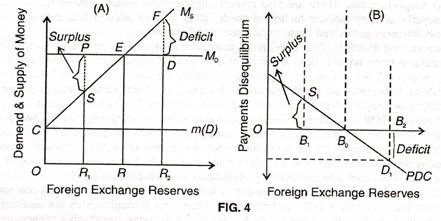Theoretical and Descriptive Analysis: BOP as a Monetary Phenomenon
A balance of payments (BOP) deficit or
surplus represents a transient stock adjustment process evoked by initial
inequality between actual; and desired money stock. The monetary approach
maintains that the BOP are essentially a monetary phenomenon and the root cause
in the payments imbalances are the disequilibrium between the demand for and
supply of money. This proposition is often called strong version of the
monetary approach.
As the Elasticity and Absorption approaches
fail to provide the correcting measures of balance of payments deficit in the
less developing countries; another approach is still available which is known
as the Monetary Approach to the Balance of Payments. According to the monetary
approach, the balance of payments is purely a monetary phenomenon. Being a
monetary phenomenon, it can be corrected only through the monetary measures.
According to the monetary approach, the balance of payments is a monetary
phenomenon is related to inflow and outflow of international reserves. If money
supply is defined as the sum of reserve and net credit creation, the monetary
authority can hold a control over only a single component of it. That is only
net credit creation. So, the monetary authority can influence the money supply
just by controlling a component of the money supply and through it the
international reserve. So, viewed from the supply side of money, the balance of
payments problem is a monetary problem and monetary policy is applicable to
control it. The monetary approach relates a country’s overall international
surplus or deficit to change in the aggregate balance sheet of its monetary
institutions.
Unlike “elasticities” and “absorption”
approaches, the MABP treat BOP as monetary problems and should be tackled by
explicitly investigating the domestic monetary behaviour .The proponents of the
monetary approach contend that beside the monetary factors, real factors do
affect BOP through monetary channels. The central point of the monetary
approach to balance-of-payments policy theory is the balance-of- payments
deficits or surpluses reflect stock disequilibrium between money demand and
supply in the market for money.
From
Your Article Library: The monetary approach to the balance of
payments is an explanation of the overall balance of payments. It explains
changes in balance of payments in terms of the demand for and supply of money. According to this
approach, “a balance of payments deficit is always and everywhere a monetary
phenomenon.” Therefore, it can only be corrected by monetary measures.
The Theoretical Analysis:
Given these assumptions,
the monetary approach can be expressed in the form of the following
relationship between the demand for and supply of money:
The demand for money (MD)
is a stable function of income (Y), prices (P) and rate of interest (i)
MD=f(Y, P, i) …(1)
The money supply (Ms) is
a multiple of monetary base (m) which consists of domestic money (credit) (D)
and country’s foreign exchange reserves (R). Ignoring m for simplicity which is
a constant,
MS = D + R … (2)
Since in equilibrium the
demand for money equals the money supply,
MD = Ms .. (3)
or MD = D + R [MS = D +
R] …(4)
A balance of payments
deficit or surplus is represented by changes in the country’s foreign exchange
reserves. Thus
∆R = ∆MD – ∆D … (5)
Or ∆R = B … ( 6)
Where B represents
balance of payments which is equal to the difference between change in the
demand for money (∆MD) and change in domestic credit (∆D).
A balance of payments
deficit means a negative B which reduces R and the money supply. On the other
hand, a surplus means a positive B which increases R and the money supply. When
B = O, it means bop equilibrium or no disequilibrium of BOP.
The automatic adjustment
mechanism in the monetary approaches is explained under both the fixed and
flexible exchange rate systems.
Under the fixed exchange
rate system, assume that MD = MS so that BOP (or B) is zero. Now suppose the
monetary authority increases domestic money supply, with no change in the
demand for money. As a result, MS > MD and there is a BOP deficit.
People who have larger
cash balances increase their purchases to buy more foreign goods and
securities. This tends to raise their prices and increase imports of goods and
foreign assets. This leads to increase in expenditure on both current and
capital accounts in BOP, thereby creating a BOP deficit.
To maintain a fixed
exchange rate, the monetary authority will have to sell foreign exchange
reserves and buy domestic currency. Thus the outflow of foreign exchange
reserves means a fall in R and in domestic money supply. This process will
continue until MS = MD and there will again be BOP equilibrium.
On the other hand, if MS
< MD at the given exchange rate, there will be a BOP surplus. Consequently,
people acquire the domestic currency by selling goods and securities to
foreigners. They will also seek to acquire additional money balances by
restricting their expenditure relatively to their income.
The monetary authority on
its part, will buy excess foreign currency in exchange for domestic currency.
There will be inflow of foreign exchange reserves and increase in domestic
money supply. This process will continue until MS = MD and BOP equilibrium will
again be restored. Thus a BOP deficit or surplus is a temporary phenomenon and
is self-correcting (or automatic) in the long-run.
·
This is explained in Fig. 4 In Panel (A)
of the figure, MD is the stable money demand curve and MS is the money supply
curve. The horizontal line m (D) represents the monetary base which is a multiple
of domestic credit, D which is also constant. This is the domestic component of
money supply that is why the MS curve starts from point C.
·
MS and MD curves intersect at point E
where the country’s balance of payments is in equilibrium and its foreign
exchange reserves are OR. In Panel (B) of the figure, PDC is the payments
disequilibrium curve which is drawn as the vertical difference between Ms and
MD curves of Panel (A). As such, point B0 in Panel (B) corresponds to point E
in Panel (A) where there is no disequilibrium of balance of payments.
·
If MS < MD there is BOP surplus of SP
in Panel (A). It leads to the inflow of foreign exchange reserves which rise
from OR1 to OR and increase the money supply so as to bring BOP equilibrium at
point E. On the other hand, if MS > MD, there is deficit in BOP equal to DF.
·
There is outflow of foreign exchange
reserves which decline from OR2 to OR and reduce the money supply so as to
reestablish BOP equilibrium at point E. The same process is illustrated in
Panel (B) of the figure where BOP disequilibrium is self-correcting or
automatic when B1S1 surplus and B2D1 deficit are equal.
·
Under a system of flexible (or floating)
exchange rates, when B = O, there is no change in foreign exchange reserves
(R). But when there is a BOP deficit or surplus, changes in the demand for
money and exchange rate play a major role in the adjustment process without any
inflow or outflow of foreign exchange reserves.
·
Suppose the monetary authority increases
the money supply (MS > MD) and there is a BOP deficit. People having
additional cash balances buy more goods thereby raising prices of domestic and
imported goods. There is depreciation of the domestic currency and a rise in
the exchange rate.
·
The rise in prices, in turn, increases the
demand for money thereby bringing the equality of MD and MS without any outflow
of foreign exchange reserves. The opposite will happen when MD > MS, there
is fall in prices and appreciation of the domestic currency which automatically
eliminates the excess demand for money. The exchange rate falls until MD = MS
and BOP is in equilibrium without any inflow of foreign exchange reserves.
The Descriptive Analysis: How BOP as a purely monetary phenomenon?
The MABP approach
emphasizes the budget constraint imposed on the country's
international spending through which the excess of domestic flow demands over
domestic flow supplies, and of excess domestic flow supplies over domestic flow
demands, are cleared. Accordingly, surplus in trade account and capital account
respectively represent excess flow supplies of goods and securities, and a
surplus in the monetary account reflects an excess flow demand for money.
Consequently, in analyzing the money account, the rate of increase or decrease
in the country's international reserves, the monetary approach focuses on the
determinants of the excess flow demand for or supply of money. A consistent use
of budget constraint implies that the monetary approach recommends an analysis
in terms of the behavioral relationships directly relevant to the money
account, rather than an analysis in terms of the behavioral relationships
directly relevant to the other account and only indirectly to the money account
via budget constraint.
A deficit
in terms of an excess of aggregate payments over receipts has two important
aspects, its monetary implication, and its relation with the aggregate activity
of the economy. This implies one of two alternatives. The first is that the
cash balances of residents are running down, as domestic money is transferred
to the foreign exchange authority. Eventually, cash balance would approach the
minimum that the community wished to hold and in the process the disequilibrium
would cure itself, through the mechanism of rising interest rate, tighter
credit creations, reduction of aggregate expenditure, and possibly an increase
in aggregate receipts. In this case where the deficit if financed by
dishoarding; it would be self-correcting in time, but the economic policy
authorities unable to allow the self-correcting process run its course, since
the international reserves of the country may be a small fraction of the money
supply that would be exhausted well before the running down of money balance
had any significant corrective effect.
The second is that the cash balance of residents are filled again by
open market purchases of securities by the monetary or foreign exchange
authority, as would happen automatically if the monetary authority followed a
policy of pegged interest rate or the exchange authority automatically re-lent
to residents any domestic currency received from residents or foreigners in
return for sales of foreign exchange. In this case, the money supply in
domestic circulation is maintained by credit creation, so that the excess of
payments over receipts by the residents could continue indefinitely without
generating any corrective process, until reserves exhaustion force the economic
policy authorities to change their policy in some respect.
Hence,
the balance of payments deficit implies either dishoarding by residents,
increase in velocity of circulation, or credit creation by the monetary
authority to maintain money supply. Similarly, the balance of payments surplus
necessarily involves either an increase in hoarding by domestic residents or a
decline in domestic credit created by the central bank. Since a deficit
associated with increasing velocity of circulation will tend to be
self-correcting, a continuing balance of payments deficit ultimately requires
credit creation to keep it going. Therefore, we consider balance of payments
deficit as being essentially monetary phenomenon under either of two cases: too
low a ratio of the international reserve relative to the domestic money supply,
so that the economic policy authorities cannot rely on the natural
self-correcting process, or follow of governmental policies which oblige the
authorities to feed the deficit by credit creation.
The
difference between Keynesian and monetary models of the open economy is that
the Keynesian assumes that the central bank can sterilize the effect of the
balance of payments on the money stock, while Monetarists are models in which
sterilization does not occur. This is because sterilization involves motivating
(rising or falling interest rate) wealth holders to alter continuously their
portfolio balance between money and bonds. This in turn reinforces surplus or
deficit on balance of payments through capital flow and outflow. The important
conclusion is that a country which operates a fixed exchange rate or managed
float cannot have an exogenously determined money supply unless it can be
sterilized successfully.
The
money supply cannot be controlled by the monetary authorities because it is
affected by the balance of payments, which in turn depends on decision of the
private sector, given the exchange rate the monetary authorities decide to
maintain. If foreign currency flows cannot be sterilized, then the government
cannot choose both the exchange rate and the money supply targets. If the
government chooses a particular exchange rate, then the money supply has to
adjust to be consistent with it.
Under
flexible exchange rate the balance of payments remain at zero because the exchange
rate adjusts to achieve overall balance of payments equilibrium. The domestic
money supply therefore is exogenous because the base money is exogenous in the
same way as in closed economy. The government can now select the stock of money
as a policy target, but has to accept whatever the rate of exchange that is
consistent with money supply target.
If
the exchange rate is managed then the resulting imbalance of the balance of
payments affects it so that the domestic money supply is endogenous.
Anti-monetarists
argue that the money supply is not exogenous under any circumstances because
the multiplier (m) varies substantially and erratically and because the base
money is not under monetary authorities control. Instead they have to vary the
base money in response to the private sectors' demand for credit and money,
hence the money supply always adjusts to whatever the demand for it.
Given
this difficultly of sterilizing a persistent surplus or deficit over an
extended time period, the monetary approach to the theory of the balance of
payments adjustment mechanism is along run phenomenon. Musa (1976) noted this
phenomenon by stating that the feature of the monetary approach is a
concentration on the long run consequences of monetary policy and parametric
changes for the behavior of the balance of payments coupled with an eclectic
view of the processes through which these long run consequences come about.
Mundell (1960) demonstrated that monetary policy is a more effective than
fiscal policy, in attaining external balance, because monetary policy improves
both the current and capital accounts of the balance of payments.
Under
fixed exchange rate an expansionary monetary policy must always leads to a
deterioration in the BOF, while a contractionary monetary policy will always
lead to an improvement in the Balance of Finance (BOF). When monetary policy
starts from an equilibrium position with BOF zero, its effects are nullified in
the long run under a fixed exchange rate. Here the money stock must be largely
endogenous. This conclusion also holds for an open economy model with perfect
capital mobility. If monetary expansion occurs when the BOF is in surplus, then
this would speed up the increase in the money stock that would have eventually
occurred as a result of a surplus. The surplus will diminish and there will be
smaller accumulation of foreign reserves as a result of monetary expansion.
Here the effect of the policy on the domestic money stock will not be
nullified. Similarly, when the BOF is in deficit under a fixed exchange rate, a
monetary contraction will accelerate the adjustment in the domestic money stock
that would eventually occurred as a result of foreign exchange reserve losses.
This will limit the extent of reserve loss and in this case the money
contraction is not nullified in the long run.
Thus the monetary approach views the BOP as a purely monetary
phenomenon, with money play a fundamental role in its determination.



Comments